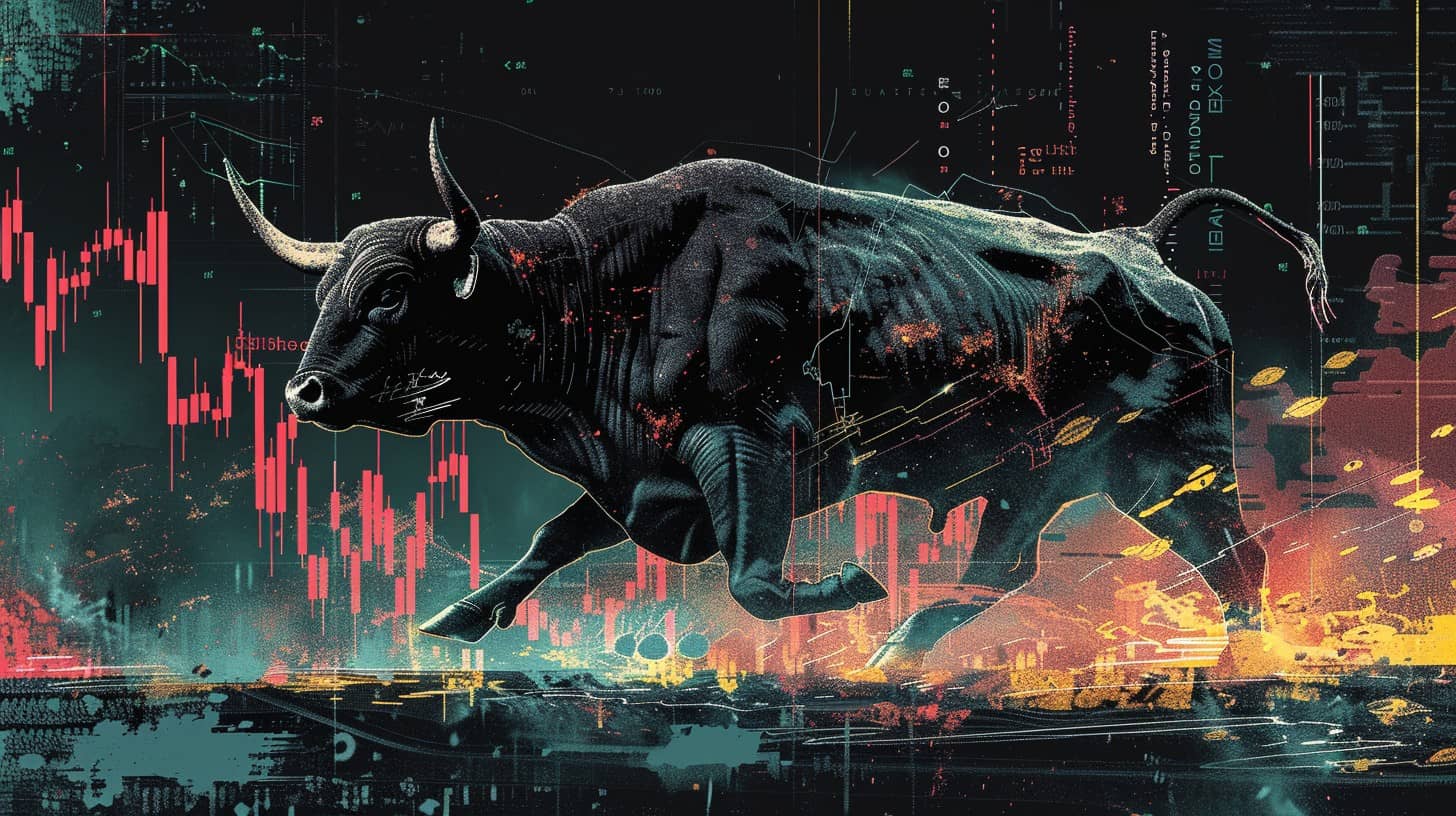Crypto bull runs can make or break fortunes. These periods of rapid price growth often last 12-18 months, but timing them is tricky. Smart investors need to understand key indicators and market cycles to capitalize on these opportunities. 1
As a blockchain analyst with 10 years of experience studying crypto trends, I’ve seen the ups and downs firsthand. This article breaks down 7 crucial insights about crypto bull runs.
You’ll learn how to spot them, what drives them, and how to prepare your portfolio. Ready to level up your crypto game? 3
Key Takeaways
Crypto bull runs typically last 12-18 months, with prices rising 10-20 times their previous lows.
Key indicators of bull runs include sharp price increases of 20%+ in a week, rising hash rates, more wallet addresses, and growing institutional interest.
Bitcoin halving events, occurring every four years, often trigger bull runs. The next halving is in March 2024.
Analysts predict the current bull run could peak in late 2025, with Bitcoin potentially reaching $175,319.
Savvy investors can prepare for bull runs by diversifying their portfolio, setting clear profit targets, using stop-loss orders, and staying informed on market trends and regulations.
Table of Contents
Understanding Crypto Bull Runs

Crypto bull runs spark excitement and drive prices up. They’re marked by rising values, increased trading, and growing interest in digital assets.
Key Characteristics and Indicators
Crypto bull runs show distinct patterns. Sharp price increases, often 20% or more in a week, signal the start. 1 Trading volumes spike, and social media buzzes with crypto talk. Positive news, like Bitcoin ETF approvals or major companies adopting crypto, fuels momentum.
These runs typically last 12-18 months, with prices rising 10-20 times their previous lows.
Key indicators include rising hash rates, increased wallet addresses, and growing institutional interest. The Bitcoin halving event, occurring every four years, often triggers bull runs. 2 Market sentiment tools like the Crypto Fear & Greed Index help gauge investor emotions. Understanding these signals is crucial for those looking to learn how to make money with cryptocurrency.
The market is a device for transferring money from the impatient to the patient. – Warren Buffett
The next section will delve into comparing crypto bull runs with traditional stock markets.
Comparison with Stock Markets
While crypto markets share some similarities with traditional stock markets, they differ significantly in volatility and regulatory oversight. This comparison highlights key distinctions:
| Aspect | Crypto Markets | Stock Markets |
|---|---|---|
| Trading Hours | 24/7 | Limited to business hours |
| Volatility | Extreme | Moderate |
| Regulation | Limited | Strict |
| Market Cap | $1.2 trillion (2023) | $40.7 trillion (NYSE, 2023) |
| Liquidity | Variable | High |
| Barrier to Entry | Low | Higher |
Crypto bull runs often outpace stock market rallies in intensity and duration. 3 Bitcoin’s dominance rises at the start of bull markets, influencing altcoin valuations positively. Future market dynamics hinge on spot Bitcoin ETF flows and macroeconomic factors. Despite volatility, Bitcoin shows promise as an asset class. 1
History of Crypto Bull Runs

Crypto bull runs have shaped the digital currency landscape since Bitcoin’s inception. The first major surge in 2017 saw Bitcoin hit $20,000, followed by a crash and a longer run from 2020 to 2021.
The Initial Bull Run
The first crypto bull run marked a pivotal moment in digital currency history. Bitcoin’s meteoric rise from $0.008 to $1,150 between 2009 and 2013 set the stage for future market cycles. 4
- Bitcoin’s launch in 2009 at $0.008 sparked initial interest among tech enthusiasts and early adopters
- 2010 saw the first real-world Bitcoin transaction – 10,000 BTC for two pizzas, valued at $41
- Mt. Gox exchange opened in 2010, facilitating easier Bitcoin trading and price discovery
- Bitcoin hit $1 for the first time in February 2011, signaling growing mainstream awareness
- Price surged to $31 by June 2011 before a sharp correction to $2 by November
- 2013 marked the first major bull run, with Bitcoin rising from $13 to $266 by April
- Cyprus banking crisis in March 2013 fueled Bitcoin adoption as a hedge against financial instability
- Bitcoin broke $1,000 in November 2013, reaching an all-time high of $1,150 in December
- The bull run ended with an 85% drawdown to $171 by January 2015
- This initial cycle established Bitcoin’s volatility and potential for explosive growth. 5
The aftermath of the first bull run paved the way for the subsequent market cycle.
The Subsequent Bull Run
Crypto markets experienced another significant bull run in 2020-2021. This surge saw Bitcoin reach an all-time high of $68,700 in November 2021.
- Bull run duration: Lasted approximately 18 months, aligning with historical trends 5
- Catalyst: Institutional adoption, including Tesla’s $1.5 billion Bitcoin purchase
- Peak market cap: Total crypto market cap surpassed $3 trillion in November 2021
- Altcoin performance: Ethereum hit $4,800, while meme coins like Dogecoin soared
- DeFi boom: Decentralized finance protocols gained traction, fueling market growth 1
- NFT craze: Non-fungible tokens emerged as a hot trend, driving Ethereum prices
- Regulatory impact: Increased scrutiny from governments affected market sentiment
- Exchange growth: Crypto exchanges like Binance saw record trading volumes
- Retail participation: Social media hype attracted new investors to the crypto space
- Market correction: Bull run ended with a 77% drawdown, Bitcoin bottoming at $15,600
Current Trends
Crypto markets are heating up. Bitcoin’s price surged past $50,000 in February 2024, sparking renewed interest. This rally coincides with the approval of spot Bitcoin ETFs and the upcoming Bitcoin halving in March 2024.
Analysts predict a bull run peak in late 2025, with Bitcoin potentially reaching $175,319. 6 Layer 2 solutions like Optimism and Arbitrum are gaining traction, offering faster and cheaper transactions on top of Ethereum.
Market sentiment has shifted bullish, driven by institutional adoption and technological advancements. CoinCodex forecasts Bitcoin to hit $156,000 by October 2024 and peak at $179,000 in August 2025. 5 DeFi protocols and NFT projects are experiencing increased activity. These trends set the stage for analyzing the duration of crypto bull runs.
Analysis of Crypto Bull Run Durations

Crypto bull runs vary in length, often lasting between 12 to 18 months. Market data shows these periods of rapid growth can be unpredictable, influenced by factors like technological breakthroughs and regulatory shifts.
Average Lengths of Past Bull Runs
Crypto bull runs typically last 12 to 18 months. 1 Past cycles show consistent patterns in duration and intensity.
| Bull Run | Duration | Peak Price Increase |
|---|---|---|
| 2017 | ~15 months | ~1,900% |
| 2020-2021 | ~18 months | ~1,100% |
Data shows peaks occur within 12-18 months. 7 The 2017 rally saw Bitcoin surge nearly 1,900%. In 2020-2021, Bitcoin climbed from $5,000 to over $60,000. 7 These patterns help investors time market entry and exit strategies. Understanding average lengths aids in portfolio management and risk assessment.
Factors Affecting Duration
Crypto bull run durations vary widely due to multiple influencing factors. Understanding these elements helps investors make informed decisions.
- Market Sentiment: Investor confidence and enthusiasm drive prices up. Social media buzz, celebrity endorsements, and positive news coverage can extend bull runs.
- Regulatory Environment: Government policies and regulations impact market stability. Clear, supportive frameworks often prolong bull markets, while restrictive measures can abruptly end them.
- Technological Advancements: Innovations in blockchain technology and new use cases for cryptocurrencies fuel investor interest. DeFi, NFTs, and Web 3.0 developments have sustained recent bull runs. 9
- Macroeconomic Conditions: Global economic factors, including inflation rates and fiat currency devaluation, influence crypto adoption. Economic uncertainty often drives investors towards digital assets.
- Halving Events: Bitcoin’s periodic halving reduces block rewards, affecting supply and demand dynamics. These events historically precede bull markets.
- Institutional Adoption: Large-scale investments from corporations and financial institutions provide legitimacy and liquidity. Tesla’s $1.5 billion Bitcoin purchase in 2021 extended the bull run.
- Network Effects: As more users join crypto networks, their value and utility increase. This positive feedback loop can prolong bull markets.
- Market Maturity: As the crypto market evolves, it becomes more resilient to short-term fluctuations. Increased stability can lead to longer bull runs. 8
These factors interact in complex ways, shaping the duration of crypto bull runs. We can examine the driving forces behind these market surges.
Driving Forces Behind Crypto Bull Runs

Blockchain tech breakthroughs fuel crypto bull runs. Market sentiment shifts and regulatory changes also play crucial roles in driving these upward trends.
Innovations in Blockchain Technology
Ethereum 2.0 revolutionizes blockchain tech. Its shift to Proof-of-Stake cuts energy use by 99.95%, boosting scalability and security. 6 The triple halving – lower issuance, fee burning, and staking – makes ETH deflationary.
Post-transition, ETH supply declines at -0.229% yearly.
Smart contracts evolve. Ethereum improvements enable complex DApps and DeFi protocols. Cross-chain interoperability advances, linking diverse networks. Zero-knowledge proofs enhance privacy in transactions. 10 These innovations drive market dynamics, reshaping the crypto landscape for savvy investors.
Effects of Regulatory Changes
Regulatory shifts impact crypto markets significantly. Positive news, like clearer guidelines or mainstream adoption, can spark bull runs. The SEC’s approval of Bitcoin ETFs in January 2024 led to a price surge. 2 Conversely, crackdowns or strict rules cause volatility and bearish trends. China’s 2021 crypto ban triggered a 50% price drop. 11 Savvy investors monitor regulatory developments closely.
They adapt strategies to comply with new rules and capitalize on emerging opportunities. Blockchain networks evolve to meet compliance standards, enhancing legitimacy and attracting institutional investors.
Impact of Market Sentiment
Market sentiment drives crypto bull runs. Social media chatter, Google searches, and trading volumes reflect investor mood. Bullish sentiment attracts new buyers, pushing prices up.
Fear of missing out (FOMO) kicks in, creating a self-fulfilling cycle.
Data shows mixed signals in current market sentiment. Bitcoin’s dominance is rising, typical of early bull markets. 1 Decreased exchange holdings suggest investors are hodling long-term.
Yet retail interest lags behind 2020-2021 levels. This conflicting data makes predicting the next bull run challenging.
Be fearful when others are greedy, and greedy when others are fearful. – Warren Buffett
Forecasting Future Crypto Bull Runs

Crypto market cycles often follow patterns, but future bull runs depend on tech breakthroughs, global events, and investor sentiment. Want to know more about spotting the next big crypto surge?
Market Cycle Trends
Market cycles in crypto follow predictable patterns. These patterns provide insights for savvy investors:
- Four-year cycles dominate the crypto market, aligning with Bitcoin halving events. 8
- Bull runs typically last 12-18 months, followed by 2-3 year bear markets.
- Longer bear markets often precede more explosive bull runs.
- Bitcoin leads market cycles, with altcoins following its price action.
- Exponential price increases mark the late stages of bull markets.
- FOMO (fear of missing out) drives parabolic price rises near cycle peaks.
- Sharp corrections of 30-40% are common even during bull trends.
- Moving averages like the 200-day MA act as key support/resistance levels.
- Extreme sentiment shifts from fear to greed signal cycle transitions. 13
- On-chain metrics like MVRV ratio help identify cycle bottoms and tops.
Economic Factors at Play
Economic factors significantly influence crypto bull runs. Key elements shape market dynamics and investor behavior.
- Interest Rates: The Fed’s rate hike to 5.25-5.50% impacts crypto markets. Higher rates can reduce risk appetite, potentially slowing bull runs. 14
- Recession Outlook: Analysts predict a mild recession, affecting investor sentiment. Economic downturns often alter investment strategies, impacting crypto demand.
- Global Economic Health: Overall economic conditions influence crypto adoption. Strong economies may boost investor confidence, fueling bull runs.
- Inflation Trends: Rising inflation can drive investors to crypto as a hedge. This increased demand can spark or extend bull runs.
- Monetary Policies: Central bank decisions on money supply affect crypto markets. Expansionary policies may boost crypto as an alternative investment.
- Regulatory Environment: Changes in crypto regulations impact market sentiment. Clear, favorable regulations can encourage institutional investment, supporting bull runs.
- Technological Advancements: Innovations in blockchain and DeFi drive crypto adoption. Breakthroughs can trigger new investment waves, potentially starting bull runs. 1
- Market Liquidity: Available trading volume affects price movements. Higher liquidity can sustain longer bull runs by absorbing larger trades.
Investment strategies must adapt to these economic factors. Let’s explore effective preparation techniques for the next crypto bull run.
Preparing for the Next Crypto Bull Run

Savvy investors can prep for the next crypto surge by diversifying their holdings, setting clear profit targets, and staying informed on market trends… Ready to learn more about riding the crypto wave?
Investment Strategies
Investment strategies are essential for managing crypto bull runs. According to the crypto experts at Unfinished Man, these approaches can help maximize returns while managing risks.
- Portfolio diversification: Spread investments across various crypto assets, including Bitcoin, Ethereum, and altcoins. This reduces exposure to single-asset volatility. 15
- Dollar cost averaging: Set up regular purchases of crypto assets regardless of price. This strategy mitigates the impact of market fluctuations over time.
- Profit-taking: Establish clear targets for selling portions of your holdings during price surges. This locks in gains and reduces overall portfolio risk.
- Stablecoin allocation: Keep a percentage of your portfolio in stablecoins like USDT or USDC. This provides liquidity for buying opportunities during market dips.
- Technical analysis: Use indicators like MACD and Bollinger Bands to identify potential entry and exit points in the market.
- Leverage management: If using margin trading on a crypto exchange, set strict limits on leverage to prevent excessive losses during market downturns.
- Blockchain innovation tracking: Stay informed about developments in decentralized finance (DeFi) and non-fungible tokens (NFTs). These sectors often lead bull market trends.
- Regulatory awareness: Monitor changes in cryptocurrency regulations globally. Positive regulatory news can fuel bull runs, while negative news can trigger corrections.
- Social sentiment analysis: Track crypto discussions on platforms like Twitter and Reddit. Sentiment shifts often precede market movements.
- Risk tolerance assessment: Align investment choices with your personal risk profile. High-risk, high-reward strategies aren’t suitable for everyone. 13
Techniques for Risk Management
Savvy crypto investors use proven risk management techniques. These strategies help safeguard portfolios and maximize potential gains.
- Diversification: Spread investments across various cryptocurrencies, sectors, and market caps. Include stable coins, DeFi tokens, and established projects like Bitcoin and Ethereum.
- Stop-loss orders: Set automatic sell triggers at predetermined price levels to limit potential losses. Adjust these levels based on market volatility and personal risk tolerance.
- Dollar-cost averaging: Invest fixed amounts at regular intervals to reduce the impact of price fluctuations. This strategy helps mitigate the risks of market timing.
- Position sizing: Limit each investment to a small percentage of your total portfolio. A common rule is not to allocate more than 1-5% to any single asset.
- Research and due diligence: Analyze project fundamentals, team backgrounds, and technological innovations before investing. Stay updated on regulatory changes and market trends. 16
- Use of hardware wallets: Store significant holdings in offline, cold storage devices to protect against hacks and cyber threats. Keep private keys secure and backed up.
- Risk-reward ratio analysis: Assess potential gains against possible losses for each trade. Aim for a minimum 2:1 ratio to ensure long-term profitability.
- Leverage limits: If using margin trading, set strict limits on borrowed funds. Never risk more than you can afford to lose. 17
- Regular portfolio rebalancing: Periodically adjust holdings to maintain desired asset allocations. This helps lock in gains and prevents overexposure to any single cryptocurrency.
- Emotional control: Develop a trading plan and stick to it. Avoid making impulsive decisions based on FOMO or market hype.
People Also Ask
What’s a crypto bull run?
A crypto bull run is when crypto prices rise fast. It’s driven by greed, fear, and market psychology. Investors get excited and buy more, pushing prices up.
How long do crypto bull runs usually last?
Bull runs vary. Some last weeks, others months. Bitcoin halvings often trigger them. Data analysis shows they can stretch 12-18 months. But markets are unpredictable.
What causes a crypto bull run to end?
Several factors can end a bull run. Overvalued assets, negative news, or regulatory changes can spark sell-offs. Market corrections or “crypto winters” follow. Prices drop sharply.
How can investors profit during a bull run?
Savvy investors use various strategies. They might trade on cryptocurrency exchanges or use contracts for difference. Some leverage automated trading or copy-trading. Diversifying portfolios is key.
Are there risks in crypto bull markets?
Yes, risks are high. Prices can crash suddenly. Investors might make rash decisions due to FOMO. It’s crucial to manage risk. Don’t invest more than you can lose.
How do bull runs affect the broader crypto ecosystem?
Bull runs boost the whole crypto world. They attract attention to blockchain tech. More people invest in cryptos, tokens, and decentralized applications. This growth can fuel innovation in the space.
References
^ https://www.grayscale.com/research/reports/anatomy-of-a-bitcoin-bull-market (2024-03-25)
^ https://www.litefinance.org/blog/for-beginners/how-to-trade-crypto/what-is-a-bull-run-in-crypto/ (2024-05-15)
^ https://tradedork.medium.com/how-do-bull-markets-impact-the-cryptocurrency-market-08fb80c12cb1
^ https://www.wayex.com/blog/a-historical-recap-of-past-crypto-bull-and-bear-markets (2023-02-17)
^ https://101blockchains.com/crypto-bull-and-bear-markets-history/
^ https://medium.com/@mick.pesser_15490/when-will-the-next-cryptocurrency-bull-run-really-begin-10a34493954d
^ https://www.iconomi.com/blog/how-long-does-a-crypto-bull-run-last
^ https://www.liquidloans.io/vault/research/blockchain/when-is-the-next-crypto-bull-run
^ https://www.sciencedirect.com/science/article/pii/S2214635022001071
^ https://www.forbes.com/sites/digital-assets/2024/03/03/what-investors-should-know-about-this-bitcoin-bull-market/
^ https://www.linkedin.com/pulse/lessons-from-historic-crypto-bull-markets-new-insights-hylafunds-7vrpc
^ https://www.ncbi.nlm.nih.gov/pmc/articles/PMC10773860/
^ https://www.tokenmetrics.com/blog/next-crypto-bull-run
^ https://www.linkedin.com/pulse/when-crypto-bull-market-return-analyzing-key-factors-investor-wdkrf
^ https://kriptomat.io/finance-investing/bull-market-strategies/
^ https://kaironlabs.com/blog/how-to-prepare-for-the-next-bull-run
^ https://www.nasdaq.com/articles/5-tips-to-help-you-prepare-for-the-next-crypto-bull-run (2023-11-17)



